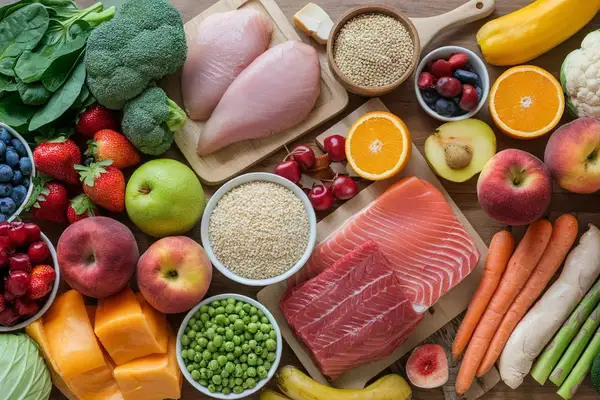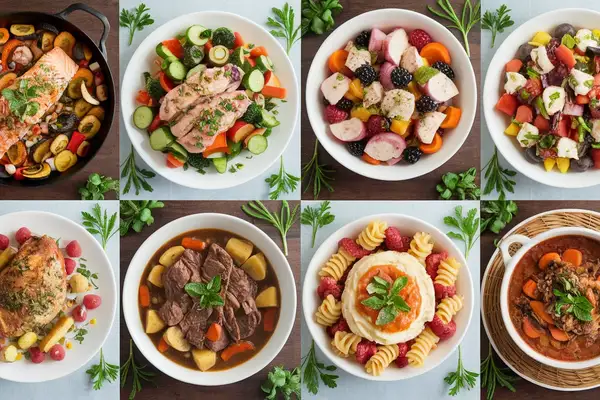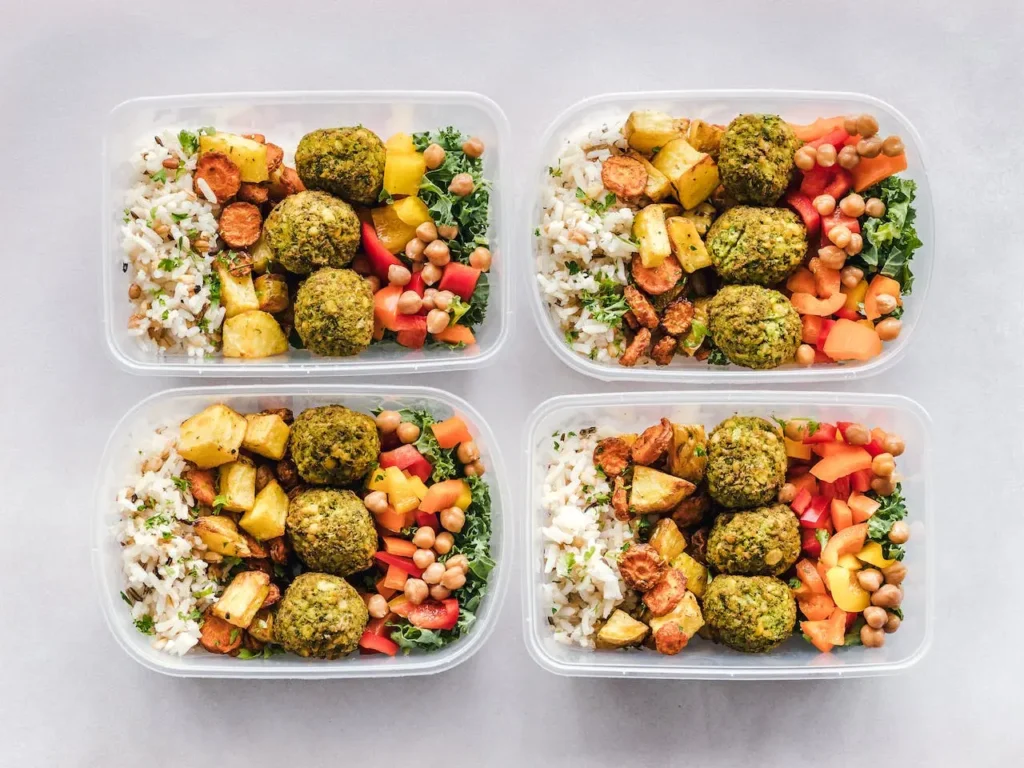Foods to Avoid While on Saxenda | 7-Day Saxenda Diet Plan
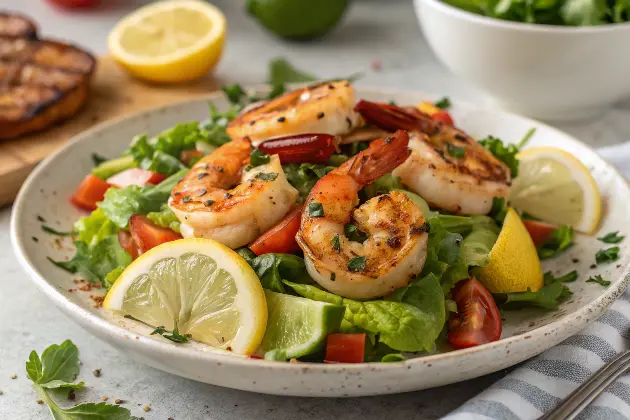
This post may contain affiliate links, meaning I may earn a commission if you make a purchase, at no extra cost to you. I only recommend products I trust. Thank you for your support.
Saxenda is a prescription injectable medication whose active ingredient is liraglutide. It belongs to a class of drugs called GLP‑1 (glucagon‑like peptide‑1) receptor agonists.
Originally developed for managing type 2 diabetes (as Victoza), Saxenda is specifically approved for chronic weight management in adults with a body mass index (BMI) ≥ 30 kg/m² (obesity) or ≥ 27 kg/m² (overweight) plus at least one weight‑related condition (e.g., high blood pressure, type 2 diabetes, or high cholesterol).
Saxenda works by mimicking a hormone called GLP-1, which helps regulate appetite and glucose levels in the body.
When combined with a reduced-calorie diet and increased physical activity, Saxenda can help people lose weight and keep it off.
This 7-day Saxenda diet plan isn’t a rigid meal plan but rather the nutritional and lifestyle framework recommended to maximize Saxenda’s effectiveness and safety.
Key principles of the Saxenda diet include:
1. Calorie Control & Portion Awareness
- Aim for a moderate calorie deficit (typically 500–750 kcal/day below maintenance).
- Measure portions using cups, a kitchen scale, or visual cues (e.g., palm‑sized protein servings).
2. Macronutrient Balance
- High protein (20–30 g per meal) to preserve lean muscle mass and promote satiety.
- Moderate healthy fats (nuts, seeds, avocado, olive oil) to slow digestion and support nutrient absorption
- Complex carbohydrates (whole grains, legumes, fiber‑rich fruits and veg) in controlled portions to stabilize blood sugar.
3. Emphasis on Nutrient‑Dense, Low‑Energy Foods
- Non‑starchy vegetables such as leafy greens, broccoli, cauliflower, peppers.
- Lean proteins such as skinless poultry, fish, egg whites, low‑fat dairy, legumes, tofu.
- Low‑glycemic fruits such as berries, green apples (eat with protein or fat).
4. Hydration & Beverages
- Drink plenty of water (8–10 cups/day) to help manage hunger and support digestion.
- Limit or avoid sugar‑sweetened drinks, high‑calorie coffee drinks, and excessive alcohol.
5. Meal Timing & Structure
- Plan 3 balanced meals plus 1–2 protein‑rich snacks per day.
- Don’t skip meals to prevent blood‑sugar dips and rebound hunger.
6. Lifestyle Integration
- Aim for ≥ 150 minutes of moderate exercise per week (e.g., brisk walking, cycling) plus strength training.
- Mindful eating, keeping a food journal, setting realistic, incremental goals.
7-Day Saxenda Diet Plan
This Saxenda diet plan includes low glycemic foods to help stabilize blood sugar levels, support healthy weight loss, and enhance the effectiveness of the medication.

Day 1
Breakfast:
- Egg white veggie scramble: 4 egg whites whisked with ½ cup diced bell peppers, ¼ cup diced onion, and ¼ cup sliced mushrooms, provides lean protein and fiber to keep you full without excess carbs.
Lunch:
- Tuna‑stuffed tomato: 4 oz canned tuna (in water) mixed with 1 tbsp light mayonnaise, stuffed into 1 large hollowed tomato, offers omega‑3s and a hydrating vegetable base.
Dinner:
- Turkey meatballs & zucchini noodles: Five 1‑oz turkey meatballs (3 oz lean turkey) over 1½ cups spiralized zucchini, seasoned with garlic and Italian herbs, low‑carb “pasta” swap with muscle‑preserving protein.
Snacks:
- Cucumber slices with guacamole: ½ sliced cucumber paired with 2 tbsp guacamole, healthy fats plus crunch for satiety.
- Roasted chickpeas: ¼ cup chickpeas roasted with paprika, plant‑based protein and fiber to curb mid‑afternoon hunger.

Day 2
Breakfast:
- Greek yogurt spinach smoothie: 1 cup non‑fat Greek yogurt, 1 cup baby spinach, and ½ cup frozen berries, creamy protein boost with vitamins and antioxidants.
Lunch:
- Grilled shrimp salad: 6 oz grilled shrimp atop 2 cups mixed greens and ¼ cup cucumber, dressed with lemon‑olive oil, lean seafood protein and refreshing veggies.
Dinner:
- Baked cod & cauliflower rice: 6 oz cod fillet baked, served over 1 cup riced cauliflower sautéed in 1 tsp olive oil, omega‑3 fish and a low‑calorie rice alternative.
Snacks:
- Hard‑boiled egg with paprika: One hard‑boiled egg sprinkled with smoked paprika, portable protein snack.
- Snap peas: 1 cup raw snap peas, fiber‑rich and naturally sweet.
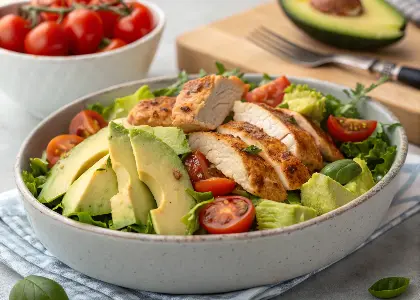
Day 3
Breakfast:
- Cottage cheese & strawberries: 1 cup low‑fat cottage cheese topped with ½ cup sliced strawberries, combines casein protein with natural sweetness.
Lunch:
- Chicken avocado salad: 4 oz sliced chicken breast, ¼ diced avocado, 2 cups mixed greens, and cherry tomatoes, healthy fats plus lean poultry.
Dinner:
- Beef & broccoli stir‑fry: 5 oz lean beef strips stir‑fried with 1 cup broccoli and 1 tbsp low‑sodium soy sauce, iron‑rich protein paired with cruciferous veggies.
Snacks:
- Raw almonds: 12 whole almonds, good source of monounsaturated fats.
- Bell pepper strips with hummus: ½ cup sliced bell pepper and 2 tbsp hummus, for a crunchy, fiber‑filled bite.

Day 4
Breakfast:
- Protein pancake: Blend 1 scoop whey protein powder, 1 egg, and ¼ cup oats; cook as a pancake, satisfying texture with sustained protein release.
Lunch:
- Salmon lettuce wrap: 4 oz canned salmon mixed with 1 tbsp light yogurt, wrapped in 2 romaine leaves, omega‑3 fats in a carb‑free wrap.
Dinner:
- Grilled Salmon Kebabs with Dill Yogurt Sauce: 6 oz salmon chunks, 1 cup mixed bell peppers/onions, grilled on skewers.
Snacks:
- String cheese: One low‑moisture, part‑skim cheese stick, calcium and protein in a convenient form.
- Cherry tomatoes: 1 cup, low‑calorie sweetness.

Day 5
Breakfast:
- Chia seed pudding: 3 tbsp chia seeds soaked overnight in 1 cup unsweetened almond milk, topped with ¼ cup raspberries, omega‑3s, fiber, and a touch of natural sweetness.
Lunch:
- Grilled tofu & bok choy: 6 oz extra‑firm tofu grilled, served with 1 cup steamed bok choy drizzled with tamari, plant protein with cruciferous greens.
Dinner:
- Pork tenderloin & sautéed spinach: 6 oz roasted pork tenderloin paired with 1 cup garlic‑sautéed spinach, rich in iron and lean meat protein.
Snacks:
- Edamame: ½ cup shelled and steamed, complete plant protein.
- Turkey jerky: 1 oz low‑sodium, portable, savory protein.
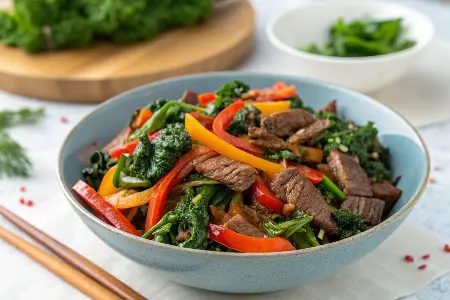
Day 6
Breakfast:
- Smoked salmon & avocado plate: 3 oz smoked salmon with ¼ sliced avocado and a lemon wedge, healthy fats and amino acids for breakfast.
Lunch:
- Egg salad cucumber boats: Two chopped hard‑boiled eggs mixed with 1 tbsp light mayo, scooped into cucumber halves, crunchy, low‑carb vessel.
Dinner:
- Beef and Kale Stir‑Fry: 6 oz beef strips, 1 cup kale, 1/2 cup sliced bell peppers, stir‑fried in a light low-sodium soy sauce.
Snacks:
- Cottage cheese with cinnamon: ½ cup low‑fat cottage cheese sprinkled with cinnamon, adds flavor without sugar.
- Walnuts: ¼ cup, anti‑inflammatory omega‑3 fats.

Day 7
Breakfast:
- Mini veggie frittatas: Two egg‑muffin cups (2 eggs total, ½ cup chopped spinach & mushrooms) baked, portable, protein‑packed bites.
Lunch:
- Chicken & celery soup: 6 oz shredded chicken breast and 1 cup chopped celery in 1 cup low‑sodium broth, light, hydrating, and protein‑rich.
Dinner:
- Shrimp avocado salsa: 6 oz boiled shrimp mixed with ½ diced avocado, ¼ cup tomato, cilantro, and lime juice, healthy fats plus lean seafood.
Snacks:
- Carrot sticks with tzatziki: 1 cup carrot sticks and 2 tbsp tzatziki, creamy, protein‑rich dip.
- Pumpkin seeds: 2 tbsp shelled for minerals and healthy fats.
What are the Best Foods to Eat While on Saxenda?
Choosing the low glycemic foods while on Saxenda can enhance the medication’s effectiveness and support your weight loss journey.
Here are the best foods to eat while on Saxenda:
1. Lean Proteins
- Skinless chicken breast: High in protein to support muscle maintenance and satiety.
- Turkey: Lean ground or sliced, low in fat and calories.
- White‑fish: Cod, tilapia, haddock are very low in fat, an excellent source of lean protein.
- Egg whites: Pure protein with almost zero fat or carbs.
- Low‑fat dairy: Greek yogurt, cottage cheese provides casein protein for prolonged fullness.
2. Non‑Starchy Vegetables
- Leafy greens: Spinach, kale, romaine are packed with fiber, vitamins, and minimal calories.
- Cruciferous veggies: Broccoli, cauliflower, Brussels sprouts are high fiber, low energy density to fill you up.
- Peppers, cucumbers, zucchini: Crunchy options with almost no carbs.
3. High‑Fiber Fruits (in moderation)
- Berries: Strawberries, blueberries, raspberries are lower in sugar than most fruits and rich in antioxidants.
- Green apples: Slightly lower glycemic load, eat with a protein or fat to slow absorption.
4. Whole Grains & Legumes
- Quinoa, bulgur, steel‑cut oats: Provide sustained energy; limit to ¼–½ cup servings.
- Lentils, black beans, chickpeas: Plant‑based protein and fiber; keep servings to ½ cup cooked.
5. Healthy Fats
- Avocado: Monounsaturated fats that help slow digestion—stick to ¼–½ fruit.
- Nuts & seeds (almonds, walnuts, chia seeds, flaxseeds): A handful (≈12 almonds or 1 Tbsp seeds) adds healthy fats and fiber.
- Olive oil: Use 1 tsp for cooking or dressings instead of butter.
Foods to Avoid While on Saxenda
While on Saxenda, certain foods can hinder your weight loss efforts and negatively impact your health.
Here are the primary categories of foods to avoid while on Saxenda:
1. High‑Sugar & Refined Carbs
- Sugary beverages: Sugary drinks such as soda, fruit juice, and energy drinks may cause rapid blood‑sugar spikes and empty calories.
- White bread, pastries, cookies, cakes: Low fiber, high glycemic index and undermines fullness.
- Sweetened cereals & granola bars: Often disguised sugars and minimal protein.
2. Fried & Processed Foods
- French fries, onion rings, fried chicken: Extremely calorie‑dense and high in unhealthy fats.
- Processed meats: Sausages, bacon, hot dogs are high in sodium and saturated fat.
- Chips & crackers: Refined grains and oils with little nutritional value.
3. High‑Fat & High‑Calorie Snacks
- Ice cream, cheesecake, creamy desserts: Concentrated fats and sugars.
- Full‑fat cheese & cream‑based sauces: Heavier in calories; limit or choose low‑fat versions.
- Packaged snack cakes & candy bars: Minimal protein, maximum sugar/fat.
4. Alcohol & Sweetened Cocktails
- Beer, wine, mixed drinks with syrups: Alcohol can increase appetite and add empty calories.
- Liquor with soda or juice: Often high in sugar, if you drink, choose a straight spirit with soda water.
5. High‑Sodium Convenience Foods
- Instant noodles, canned soups with added salt: Can lead to fluid retention and increased thirst.
- Frozen meals with sauces: Often high in hidden sugars, fats, and sodium.
Resources
Here are some relevant studies about the Saxenda for weight loss:
- Effect of Liraglutide (Saxenda) on Body Weight in Overweight and Obese Adults: A Systematic Review and Meta-Analysis of Randomized Controlled Trials
- Efficacy and Safety of Liraglutide (Saxenda) for Weight Management
- Liraglutide (Saxenda) as a Treatment for Obesity: Critical Appraisal of the Evidence
- Short-Term Efficacy and Safety of Liraglutide (Saxenda) in the Management of Obesity
Final Thoughts
The Saxenda diet plan is a comprehensive approach to weight loss that combines the power of the Saxenda medication with a balanced, calorie-controlled diet.
By understanding the foods to avoid while on Saxenda, the best foods to eat, and following a structured Saxenda diet plan, you can maximize the benefits of the drug and achieve your weight loss goals sustainably.
Remember, the key to success on the Saxenda diet plan is consistency, patience, and a willingness to make lifestyle changes that support your overall weight loss goals.
With the right mindset and the guidance of your healthcare provider, you can embark on a transformative journey towards a healthier, happier you.
Ready to take the first step towards a healthier you? Speak with your healthcare provider about incorporating Saxenda into your weight loss plan.
- Does Ozempic need to be refrigerated?
- 50 soft foods to eat after tooth extraction
- 12 methods how to stop GERD cough instantly
- How much is Ozempic without insurance?
- 7-day GERD diet plan
- How to make sea moss gel at home
- Is corn good for weight loss?
- 7-day meal plan for cancer patients
- 7 foods to avoid with a pituitary tumor
- Foods to avoid while breastfeeding
- Foods to avoid with UTIs
- Foods to avoid on Contrave
FAQs
Can I drink alcohol while on the Saxenda diet plan?
No, it is not recommended to consume alcohol while taking Saxenda. Alcohol can interact with the medication and increase the risk of hypoglycemia (low blood sugar). It’s best to avoid alcoholic beverages altogether during your Saxenda weight loss journey.
Can I eat carbohydrates while on Saxenda?
Yes, you can include carbohydrates in your Saxenda diet plan, but it’s important to focus on whole, fiber-rich sources like fruits, vegetables, and whole grains.
Avoid refined and sugary carbohydrates, as they can spike your blood sugar levels and undermine your weight loss efforts.
How do I know if Saxenda is working for me?
The primary indicator that Saxenda is working for you is weight loss. Most people can expect to lose 5-10% of their body weight within the first 12 weeks of taking Saxenda when combined with a calorie-controlled diet and increased physical activity.
Additionally, you may notice a decrease in hunger and cravings, as well as improvements in your energy levels and overall well-being.
What are the potential side effects of Saxenda?
The most common side effects of Saxenda include nausea, diarrhea, constipation, vomiting, and headache. These side effects are often mild and tend to subside as your body adjusts to the medication.
Can I Eat rice on Saxenda?
Yes, whole grains like brown rice are recommended as part of a balanced diet while on Saxenda. Whole grains provide essential nutrients and fiber, which can contribute to overall weight management.
Can You Eat Spicy Food on Saxenda?
Spicy foods can potentially exacerbate stomach side effects such as nausea and upset stomach, which are common when initially beginning Saxenda. Therefore, it’s advisable to steer clear of spicy foods to help manage potential gastrointestinal discomfort.
Disclaimer: The Saxenda diet plan is intended for informational purposes only and should not be considered medical advice.
Before starting Saxenda or any weight loss regimen, consult with a healthcare provider to ensure it is appropriate for your health conditions and goals.
